Who Adopts? Characteristics of Women and Men Who Have Adopted Children
On This Page
- Key findings
- How many Americans have adopted children? What are the characteristics of people who have adopted?
- How is age associated with adoption?
- Does marital status make a difference in who adopts?
- Do only childless adults or people who have used infertility services adopt children?
- How else do adopters differ from nonadopters?
- If adults want to adopt, are there babies available?
- Summary
- Definitions
- Data source and methods
- About the authors
- References
- Suggested Citation
NCHS Data Brief No. 12, January 2009
PDF Version (916 KB)
by Jo Jones, Ph.D.
Key findings
Data from the National Survey of Family Growth
- People who have adopted are more likely to be men, to be over 30, to be ever married, to have given birth or fathered a child, and to have ever used infertility services than people who have not adopted.
- Adoptive mothers are older than non-adoptive mothers. Eighty-one percent of adoptive mothers are 35-44 years of age compared with 52% of non-adoptive mothers.
- Women who have ever used infertility services are 10 times more likely to have adopted children than women who have never used infertility services.
- Men who have fathered children are more likely to have adopted children than men who have not fathered children.
- Women with incomes below 150% of poverty and Hispanic women are the least likely to have adopted children compared with women of other characteristics.
- The percentage of infants given up for adoption has declined from 9% of those born before 1973 to 1% of those born between 1996 and 2002.
Adoption serves several important purposes in contemporary American society. It is a way for individuals and couples to form a legal parental relationship with a nonbiological child. As such, it benefits children whose birth parents are unable or unwilling to raise them and provides adults who are unable to conceive or carry a pregnancy to term a means to bring children into their families (1-3). Adoption is also used to legalize the parental relationship between a de facto parent and a nonbiological child, such as a step child, a foster child, or a child of a relative, for whom they are already providing care on a daily basis (4).
Only statistically different comparisons are presented in this data brief.
Keywords: adoption, National Survey of Family Growth
How many Americans have adopted children? What are the characteristics of people who have adopted?
In 2002, about 2 percent of the adult population aged 18-44, or nearly 2 million persons, had adopted children (4). More than twice the percentage of men (2.3) had adopted a child compared with women (1.1). These percentages represent approximately 1.3 million men and 613,000 women. Higher percentages of people over age 30, who are currently or formerly married, who have given birth or fathered a child, or who have ever used infertility services have adopted children compared with people who are aged 18-29, never married, without biological children, or who have never used infertility services.

How is age associated with adoption?
Adoptive mothers are older than mothers who have not adopted children. There is no difference in the overall age distribution between adoptive and nonadoptive fathers.
About one-half of adoptive mothers are between ages 40-44 years (51%) compared with 27% of mothers who have not adopted.
Conversely, only 3% of adoptive mothers are between ages 18-29 years compared with 27% of biological mothers.
Men adopt children at younger ages than women—more than one-quarter of adoptive fathers are aged 30-34 years compared with 16% of adoptive mothers.
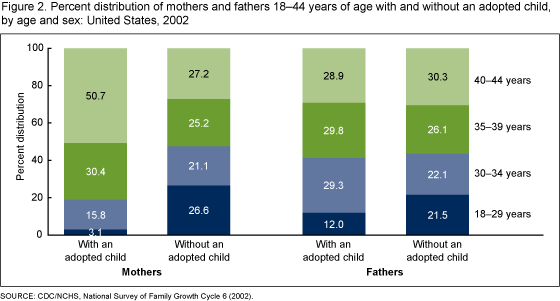
Does marital status make a difference in who adopts?
Significantly more ever-married men (4%) have adopted children than never-married men or women of either marital status.
Although never-married persons aged 18-44 years are less likely to have adopted children compared with those who have ever been married, there are about 100,000 never-married women and 73,000 never-married men who adopted children in 2002 (4).
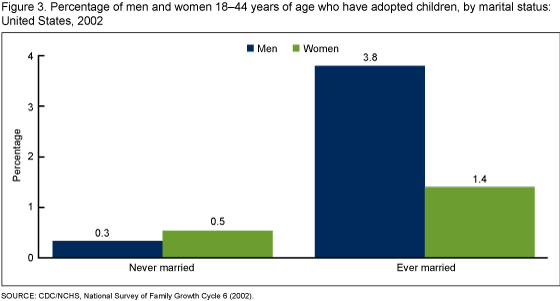
Do only childless adults or people who have used infertility services adopt children?
Men who have fathered children are more likely to have adopted a child compared with men who have not fathered children.
Equal percentages of women who have and who have not had a birth have adopted children.
Four times as many men who have fathered children have adopted children compared with women who have given birth.
When couples have troubles conceiving a child, either or both individuals may use infertility services to increase their possibility of having a biological child.
Five percent of women (or their partners) who have ever used infertility services have adopted children. This is almost 3 times the percentage adopting for men (or their partners) who have ever used services.
Women (or their partners) who have ever used infertility services are 10 times more likely than women (or their partners) who have not used infertility services to have adopted children.
Women (or their partners) who have not used infertility services are the least likely to have adopted children.
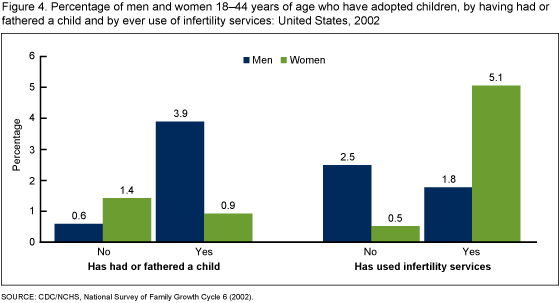
How else do adopters differ from nonadopters?
Women with incomes less than 150% of the poverty level are significantly less likely to have adopted children than women with incomes 150% of the poverty level or greater or men in either income group. Significantly fewer Hispanic women have adopted children than non-Hispanic white or black women or Hispanic, non-Hispanic white, or black men.
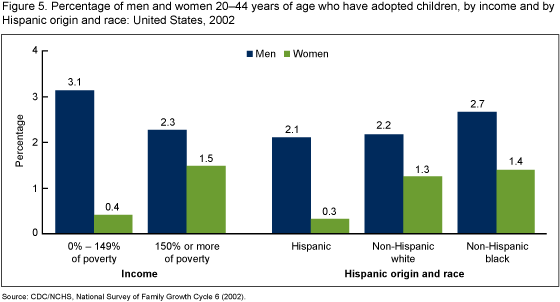
If adults want to adopt, are there babies available?
Fewer infants are available for men and women to adopt now than in the past. Never-married women continue to be the most likely group of women to relinquish an infant for adoption (4,5). Looking at births to never-married women prior to 1973, about 9% of infants overall and 20% of infants born to white never-married women were relinquished. For births occurring between 1996 and 2002, only 1% of babies born to never-married women were relinquished by their mothers for adoption within the first month of the babies’ lives.
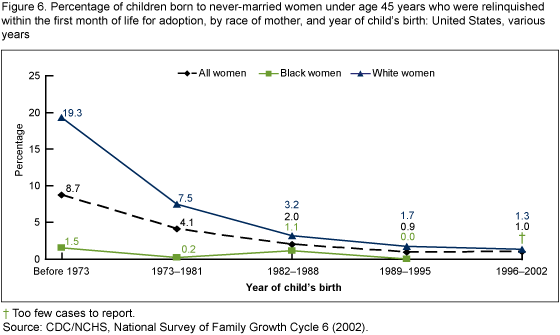
Summary
In 2002, 2 percent of adults aged 18-44 years had adopted children, approximately 2 million people. Significantly more adopters are men, over age 30, are ever married, have biological children, and have ever used infertility services. Women who have adopted are older than women who have given birth to a child. Significantly more ever-married men have adopted children compared with never-married men or women in either marital status. Women who have ever used infertility services are more likely to have adopted compared with women who have not used these services. Men who have adopted are more likely than men who have not adopted to have also fathered a child. Hispanic women are significantly less likely than non-Hispanic women or men of any race or ethnicity to have adopted children. Women with incomes below 150% of the poverty level are significantly less likely than women with higher incomes or men, irrespective of poverty status, to have adopted children. The percentage of infants relinquished by never-married mothers has declined to 1.0%, or fewer than 7,000 infants annually.
Definitions
Ever had or fathered a biological child: It is a yes or no variable that indicates whether a woman has ever given birth or a man has ever fathered a child.
Ever used infertility services: Although similar for women and men, is defined slightly differently. It is a yes or no variable indicating whether the respondent or a spouse or partner had ever sought medical help to have a baby. Women were asked two separate questions: “Have you or a husband or partner ever been to a doctor or other medical care provider to talk about ways to help you become pregnant?” and “Not counting routine check-ups, prenatal care, or advice about a pregnancy, have you ever been to a doctor or other medical care provider to talk about ways to help you prevent miscarriage or pregnancy loss?” Men were asked one question, “Did you or your wife or partner ever go to a doctor or other medical care provider to talk about ways to help you have a baby together?” This variable was computed for all women but only for men who had sexual intercourse.
Hispanic origin and race: It is defined using multiple questions. First, respondents of Hispanic or Spanish ancestry are classified as “Hispanic,” regardless of reported race. Then, non-Hispanic respondents who are only white or only black are classified as either “non-Hispanic white” or “non-Hispanic black.” The residual respondents (i.e., those of other single races and those of multiple races) were classified as “non-Hispanic other.”
Marital status: Measured at the time of the interview, it is a dichotomy indicating whether the respondent has ever been married. The ever-married category includes those respondents whose current marital status is married, widowed, separated, or divorced.
Percentage of poverty level: It is a measure of the total family income, adjusted for the number of persons in the family, relative to the annual definition of poverty provided by the U.S. Census Bureau. It is measured at the time of the interview.
Data source and methods
Data are from the Cycle 6 (2002) National Survey of Family Growth, a nationally representative study of reproductive-age women and men conducted in their homes. The final data file consists of 7,643 women and 4,928 men 15-44 years of age. For this report, respondents aged 15-17 years were not analyzed, resulting in a sample size of 6,969 women and 4,295 men. Poverty level of the household is shown only for respondents aged 20-44 years because teenagers are less likely to report household income accurately.
The numbers, percentages, averages, and other statistics shown in this report are weighted national estimates. The weights account for different sampling rates and for nonresponse bias and are adjusted to agree with population control totals provided by the U.S. Census Bureau. (See Lepkowski, et al. (6) for detailed information about sampling and weighting procedures.)
Statistics for this report were produced using SAS software, version 9.1. Standard errors were calculated, and tests of significance performed, for selected comparisons in this report. The statistical package SUDAAN was used for the calculation of standard errors, because it takes into account complex sample designs such as that of the NSFG. When two percentages were compared, differences were evaluated using two-tailed t-tests at the 0.05 level; when there were more than two categories to be compared, differences among distributions of the percentages were assessed using χ2 tests of association at the 0.05 level. Only differences that were statistically significant were discussed in this report.
About the authors
Jo Jones is with the Centers for Disease Control and Prevention’s National Center for Health Statistics, Division of Vital Statistics, Reproductive Statistics Branch.
References
- Bachrach CA, Stolley KS, London KA. Relinquishment of premarital births: Evidence from national survey data. Family Planning Perspectives 24(1):27-32. 1992.
- Bachrach CA. Adoption as a means of family formation: Data from the National Survey of Family Growth. Journal of Marriage and the Family 45(4):859-65. 1983.
- Bonham GS. Who adopts: The relationship of adoption and social-demographic characteristics of women. Journal of Marriage and the Family 39(2): 295-306. 1977.
- Jones J. Adoption experiences of women and men and demand for children to adopt by women ages 18-44 in the United States, 2002. National Center for Health Statistics. Vital Health Stat 23(27). Hyattsville, MD: National Center for Health Statistics. 2008.
- Chandra A, Abma J, Maza P, Bachrach C. Adoption, adoption seeking, and relinquishment for adoption in the United States. Advance data from vital and health statistics; no 306. Hyattsville, MD: National Center for Health Statistics. 1999.
- Lepkowski JM, Mosher WD, Davis KE, Groves RM, van Hoewyk J, Willem J. National Survey of Family Growth, Cycle 6: Sample design, weighting, imputation and variance estimation. Vital Health Stat 2(142). Hyattsville, MD: National Center for Health Statistics. 2006.
Suggested Citation
Jones J. Who adopts? Characteristics of women and men who have adopted children. NCHS data brief, no 12. Hyattsville, MD: National Center for Health Statistics. 2009.
Copyright information
All material appearing in this report is in the public domain and may be reproduced or copied without permission; citation as to source, however, is appreciated.
National Center for Health Statistics
Director
Edward J. Sondik, Ph.D.
Acting Co-Deputy Directors
Jennifer H. Madans, Ph.D.
Michael H. Sadagursky
- Page last reviewed: November 6, 2015
- Page last updated: January 19, 2010
- Content source:


 ShareCompartir
ShareCompartir